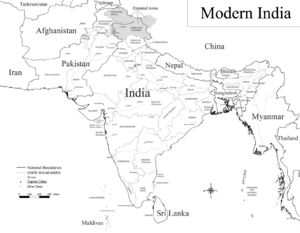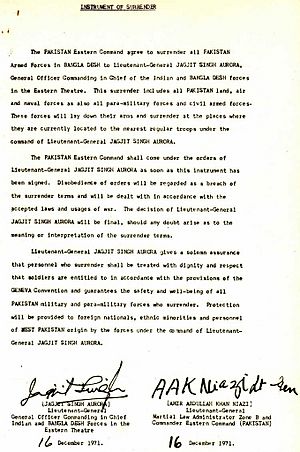Bangladesh Liberation War facts for kids
Quick facts for kids Bangladesh Liberation Warমুক্তিযুদ্ধ (Muktijuddho) |
|||||||||
|---|---|---|---|---|---|---|---|---|---|
| Part of the Indo-Pakistani conflicts and the Cold War | |||||||||
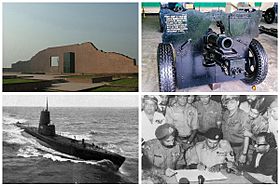 Clockwise from top left: Martyred Intellectuals Memorial; Bangladesh Forces howitzer; Lt. Gen. Amir Niazi signs the Pakistani Instrument of Surrender to Indian and Bangladeshi forces in the presence of Lt. Gen. Jagjit Singh; and the PNS Ghazi |
|||||||||
|
|||||||||
The Bangladesh Liberation War (Bengali: মুক্তিযুদ্ধ Muktijuddho) was a fight for independence in 1971. It led to the creation of the country of Bangladesh. This war involved East Pakistan (which later got help from India) fighting against West Pakistan. It lasted for about nine months. During this time, many people had to leave their homes, and millions were forced to move.
The war began on March 26, 1971, and ended on December 16, 1971. A very strong cyclone also happened during this period. Some people were held responsible for their actions during the war.
Why the War Started
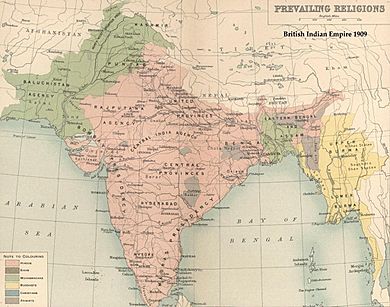
Before 1947, India was ruled by the British. When the British left, they divided the land into two new countries: Pakistan and India. Pakistan was created as a home for Muslims, and India for Hindus.
The new country of Pakistan had two main parts: West Pakistan and East Pakistan. These two parts were far apart, with India in between them. East Pakistan is now the country of Bangladesh. Even though East Pakistan had almost as many people as West Pakistan, most of the political power was in West Pakistan. Many people in East Pakistan felt that West Pakistan was not treating them fairly and was using their resources for its own benefit.
On March 25, 1971, things became very tense. An election had been won by a political party from East Pakistan, the Awami League. But the leaders in West Pakistan ignored the election results. People in East Pakistan were very unhappy and wanted more control over their own future. The West Pakistan government responded with strong and harsh actions, which they called Operation Searchlight.
Because of these actions, the leader of the Awami League, Sheikh Mujibur Rahman, declared East Pakistan independent on March 26, 1971. He named the new country Bangladesh. Most people in East Pakistan supported this idea. However, some groups sided with the Pakistan Army.
The President of Pakistan, Agha Muhammad Yahya Khan, ordered the Pakistani military to take back control. This started a conflict within the country. Many people, about 10 million, had to flee to India to find safety. India then started to help and organize the Bangladeshi resistance army, known as the Mukti Bahini.
How the War Ended
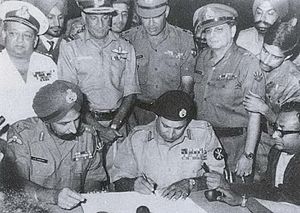
On December 16, 1971, the Pakistani forces in East Pakistan surrendered. Lt. Gen Amir Abdullah Khan Niazi, the commander of the Pakistani Army in East Pakistan, signed an official document called the Instrument of Surrender.
More than 93,000 Pakistani soldiers surrendered to the Indian and Bangladeshi forces. This was one of the largest surrenders of troops since World War II.
After the war, Bangladesh wanted to join the United Nations (UN). Most countries supported this. However, China, a close friend of Pakistan, did not allow it at first. The United States, another friend of Pakistan, was also slow to recognize Bangladesh as a new country.
To help bring peace, India and Pakistan signed an agreement in 1972 called the Simla Agreement. In this agreement, Pakistan officially recognized Bangladesh as an independent country. In return, India sent back the Pakistani soldiers who had been taken as prisoners of war. India treated these prisoners well, following international rules. They released over 93,000 Pakistani prisoners within five months. India also returned land that its troops had taken in West Pakistan during the war. This was done to help create lasting peace between the two countries.
Images for kids
-
The location of Bengali and Pakistani military units during Operation Searchlight, March 1971
-
An advertisement for former Beatle George Harrison's "Bangla Desh" song, released in July 1971 to help Bangladeshi refugees.
-
Senator Ted Kennedy led US congressional support for Bangladeshi independence
See also
 In Spanish: Guerra de liberación de Bangladés para niños
In Spanish: Guerra de liberación de Bangladés para niños


